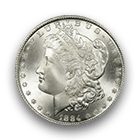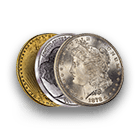Modern and semi-modern coins, while typically in better states of preservation than their earlier counterparts, present their own special set of grading challenges and intricacies. Production techniques and collector awareness of quality importance increased in the 20th century. Therefore, the surface abrasions from mishandling or improper cleaning common on early American coins gave way to more environmental forms of deterioration and grade determination, the most common of which we’ll discuss here.
Haze or translucent surface residue can negatively impact the grade of otherwise untoned semi-modern proof coinage. The illustrated Mercury Dime has very little in the way of hairlines or surface abrasions, but the uneven patination on the obverse will limit the grade, especially in the upper portion of the Sheldon scale, where eye appeal is crucial in making distinctions among largely problem-free coins. Such haze is often the result of dipping a coin with heavy or dark toning in which too much of the underlying metal has been oxidized; such pieces are best left alone.
Spotting is another common ailment on the surfaces of proof coins from the mid-20th century. Many coins stored in unopened proof sets for decades at a time emerge with thick, circular, or oval deposits surrounding a small piece of reactive debris that made it into the packaging. While examples with isolated, unmetastasized spots such as the Franklin Half Dollar depicted herein will typically still be gradeable, they will merit a significantly lower grade than an equivalent piece without this visual distraction. Extensive or severe spotting may result in an “Environmental Damage” designation if the aesthetic appeal has been so reduced as to make the coin undesirable to collectors.
Moving away from proofs to consider business strikes for a moment, of note in grading modern and semi-modern pieces is ejection damage. This is most often seen as a series of parallel scrapes on a high point of the design (e.g., the shield on the reverse of a Kennedy Half Dollar or eagle’s breast on the reverse of a Washington Quarter) incurred as the coin made its passage through metallic machinery at the Mint. While not usually a concern in the lower Mint State grades, this is frequently a key determining factor when evaluating coins in the MS65 tier or higher. The illustrated Kennedy Half Dollar shows northwest-southeast scraping on the chief of the shield. Though it likely left the U.S. Mint in that state, there are many equivalent examples available without such damage.
Collecting modern and semi-modern coins provides one of the hobby’s most enjoyable and affordable pursuits. Many superb examples can still be found in unopened proof sets, mint sets, rolls, or even at your local bank. Familiarity with a few of the most prevalent grading factors surrounding such pieces will bolster your cherry-picking success and perhaps even your PCGS Set Registry score. Happy collecting!










 Copper & Nickel
Copper & Nickel
 Silver Coins
Silver Coins
 Gold Coins
Gold Coins
 Commemoratives
Commemoratives
 Others
Others
 Bullion
Bullion
 World
World
 Coin Market
Coin Market
 Auctions
Auctions
 Coin Collecting
Coin Collecting
 PCGS News
PCGS News